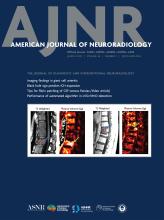This article requires a subscription to view the full text. If you have a subscription you may use the login form below to view the article. Access to this article can also be purchased.
Abstract
BACKGROUND AND PURPOSE: A national consensus recommendation for the collection of DSC-MRI perfusion data, used to create maps of relative CBV (rCBV), has been recently established for primary and metastatic brain tumors. The goal was to reduce intersite variability and improve ease of comparison across time and sites, fostering widespread use of this informative measure. To translate this goal into practice, the prospective collection of consensus DSC-MRI data and characterization of derived rCBV maps in brain metastases is needed. The purpose of this multisite study was to determine rCBV in untreated brain metastases in comparison to glioblastoma (GBM) and normal-appearing brain by using the national consensus protocol.
MATERIALS AND METHODS: Subjects from 3 sites with untreated enhancing brain metastases underwent DSC-MRI according to a recommended option that uses a midrange flip angle, GRE-EPI acquisition, and the administration of both a preload and second DSC-MRI dose of 0.1 mmol/kg gadolinium-based contrast agent. Quantitative maps of standardized relative CBV (srCBV) were generated and enhancing lesion ROIs determined from postcontrast T1-weighted images alone or calibrated difference maps, termed Δ T1 (dT1) maps. Mean srCBV for metastases were compared with normal-appearing white matter (NAWM) and GBM from a previous study. Comparisons were performed by using either the Wilcoxon signed-rank test for paired comparisons or the Mann-Whitney U nonparametric test for unpaired comparisons.
RESULTS: Forty-nine patients with a primary histology of lung (n = 25), breast (n = 6), squamous cell carcinoma (n = 1), melanoma (n = 5), gastrointestinal (GI) (n = 3), and genitourinary (GU) (n = 9) were included in comparison to GBM (n = 31). The mean srCBV of all metastases (1.83±1.05) were significantly lower (P = .0009) than mean srCBV for GBM (2.67 ± 1.34) with both statistically greater (P < .0001) than NAWM (0.68 ± 0.18). Histologically distinct metastases are each statistically greater than NAWM (P < .0001) with lung (P = .0002) and GU (P = .02) srCBV being significantly different from GBM srCBV.
CONCLUSIONS: Using the consensus DSC-MRI protocol, mean srCBV values were determined for treatment-naïve brain metastases in comparison to normal-appearing white matter and GBM thus setting the benchmark for all subsequent studies adherent to the national consensus recommendation.
ABBREVIATIONS:
- BSW
- Boxerman Schmainda Weisskoff
- dT1
- Δ T1
- GBCA
- gadolinium-based contrast agent
- GBM
- glioblastoma
- GI
- gastrointestinal
- GRE
- gradient echo
- GU
- genitourinary
- NAWM
- normal-appearing white matter
- nrCBV
- normalized relative CBV
- PSR
- percent signal recovery
- rCBV
- relative CBV
- SCC
- squamous cell carcinoma
- srCBV
- standardized relative CBV
- T1W
- T1-weighted
- © 2025 by American Journal of Neuroradiology












